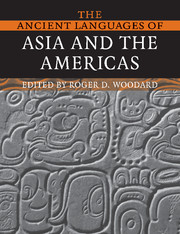Book contents
- Frontmatter
- Contents
- List of figures
- List of tables
- List of maps
- List of contributors
- Notes on numbering and cross-referencing
- List of abbreviations
- Preface
- Preface to the first edition
- 1 Language in ancient Asia and the Americas: an introduction
- 2 Sanskrit
- 3 Middle Indic
- 4 Old Tamil
- 5 Old Persian
- 6 Avestan
- 7 Pahlavi
- 8 Ancient Chinese
- 9 Mayan
- 10 Epi-Olmec
- Appendix 1 Reconstructed ancient languages
- Appendix 2 Full tables of contents from The Cambridge Encyclopedia of the World's Ancient Languages, and from the other volumes in the paperback series
- Index of general subjects
- Index of grammar and linguistics
- Index of languages
- Index of named linguistic laws and principles
5 - Old Persian
Published online by Cambridge University Press: 01 September 2010
- Frontmatter
- Contents
- List of figures
- List of tables
- List of maps
- List of contributors
- Notes on numbering and cross-referencing
- List of abbreviations
- Preface
- Preface to the first edition
- 1 Language in ancient Asia and the Americas: an introduction
- 2 Sanskrit
- 3 Middle Indic
- 4 Old Tamil
- 5 Old Persian
- 6 Avestan
- 7 Pahlavi
- 8 Ancient Chinese
- 9 Mayan
- 10 Epi-Olmec
- Appendix 1 Reconstructed ancient languages
- Appendix 2 Full tables of contents from The Cambridge Encyclopedia of the World's Ancient Languages, and from the other volumes in the paperback series
- Index of general subjects
- Index of grammar and linguistics
- Index of languages
- Index of named linguistic laws and principles
Summary
HISTORICAL AND CULTURAL CONTEXTS
Old Persian is one of two Old Iranian languages which are attested in the Achaemenid royal inscriptions (see below), members of that branch of the Indo-European language family called Indo-Iranian, or Aryan (the Persians designate themselves and their language by the term ariya–). The Iranian languages began to take shape when the ancestors of the Indo-Aryans left the common homeland in the steppes of Central Asia in the first half of the second millennium BC. The Western Iranian peoples, the Medes who settled in Media and the Persians in Fārs (speaking a Northwesternand Southwestern Iranian dialect respectively), step into the light of history in the ninth century BC, when Median names are first attested in Assyrian documents.
While “Old Persian” was certainly the language of Fārs, the variety which is attested in the Achaemenid inscriptions appears to be a rather artificial idiom, peppered with dialectal and archaic words, unlike any dialect actually spoken (characteristics of a distinct spoken Old Persian may be discerned from certain spontaneous phonetic developments, and from Old Persian words and names as rendered in other languages). The language called Old Persian was thus restricted to royal usage (as was the cuneiform script in which Old Persian was recorded). Even so, Old Persian was neither the lingua franca nor the administrative language of the Achaemenid Empire, roles fulfilled by Aramaic and, to a limited extent, various regional languages spoken within the empire.
- Type
- Chapter
- Information
- The Ancient Languages of Asia and the Americas , pp. 76 - 100Publisher: Cambridge University PressPrint publication year: 2008
- 3
- Cited by

